Awrejcewicz J. Numerical Simulations of Physical and Engineering Processes
Подождите немного. Документ загружается.

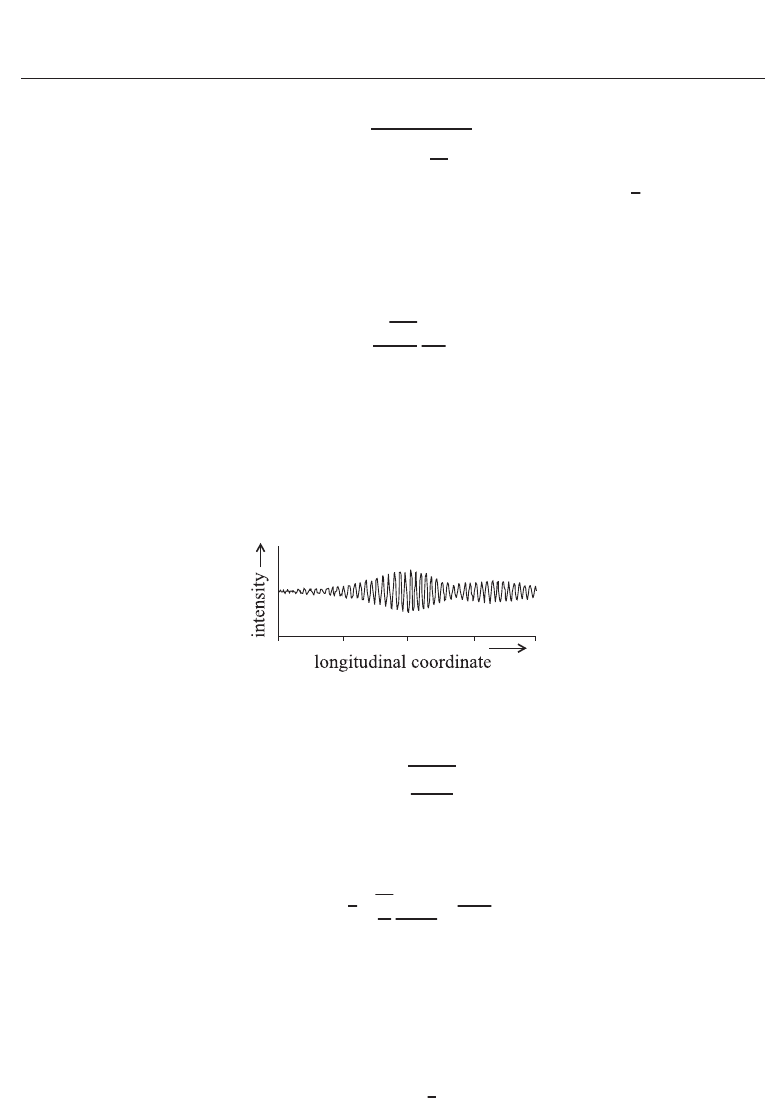
Measurement Uncertainty of White-light Interferometry on Optically Rough Surfaces 3
shape parameter M is equal to
M
=
1 + 8
σ
h
l
c
2
.(3)
If the coherence length l
c
is long and the rms roughness σ
h
is small (σ
h
<
√
8l
c
), the gamma
distribution differs only slightly from the negative exponential distribution (that corresponds
to the monochromatic illumination)(Horváth et al., 2002). The coherence length l
c
is related to
the spectral width of the light source Δλ.ForaspectralwidthΔλ much lower than the central
wavelength λ
0
of the light source, it holds (Pavlíˇcek & Hýbl, 2008)
l
c
∼
=
√
ln 2
π
λ
2
0
Δλ
.(4)
The spectral width Δλ in Eq. (4) is defined as full width at half maximum (FWHM).
George and Jain demonstrate that speckle patterns of two different wavelengths become
decorrelated if the surface roughness exceeds a certain limit (George & Jain, 1973). A similar
effect is observed with the speckle pattern produced by broadband light. If the rms roughness
is high and the coherence length is short, the speckle becomes decorrelated. A decorrelated
speckle implies a distorted correlogram. An example of a distorted correlogram is shown in
Fig. 3.
Fig. 3. Distorted white-light correlogram.
The limit beyond which the correlogram becomes distorted was found numerically
(Pavlíˇcek & Hýbl, 2008)
l
c
< 4σ
h
I
obj
I
obj
.(5)
The influence of the shot noise on the measurement uncertainty of white-light interferometry
is described in (Pavlíˇcek & Hýbl, 2011). The measurement uncertainty δz caused by shot noise
is given by
δz
=
√
2
4
2
π
N
shot
I
A
Δzl
c
,(6)
where N
shot
is the intensity of the noise, I
A
is the amplitude of the modulation of the
correlogram, and Δz is the distance between two subsequent values of the coordinate z
O
-the
sampling step. The ratio N
shot
/I
A
is the noise-to-signal ratio and the meaning of I
A
is shown
in Fig. 2. The shot noise is caused by the uncertainty in counting the incoming photons. For a
long integration time of the CCD camera (significantly longer than the coherence time of the
used light), the photocount distribution can be assumed as Poissonian (Peˇrina, 1991). Then
N
shot
=
√
I,(7)
493
Measurement Uncertainty of White-Light Interferometry on Optically Rough Surfaces
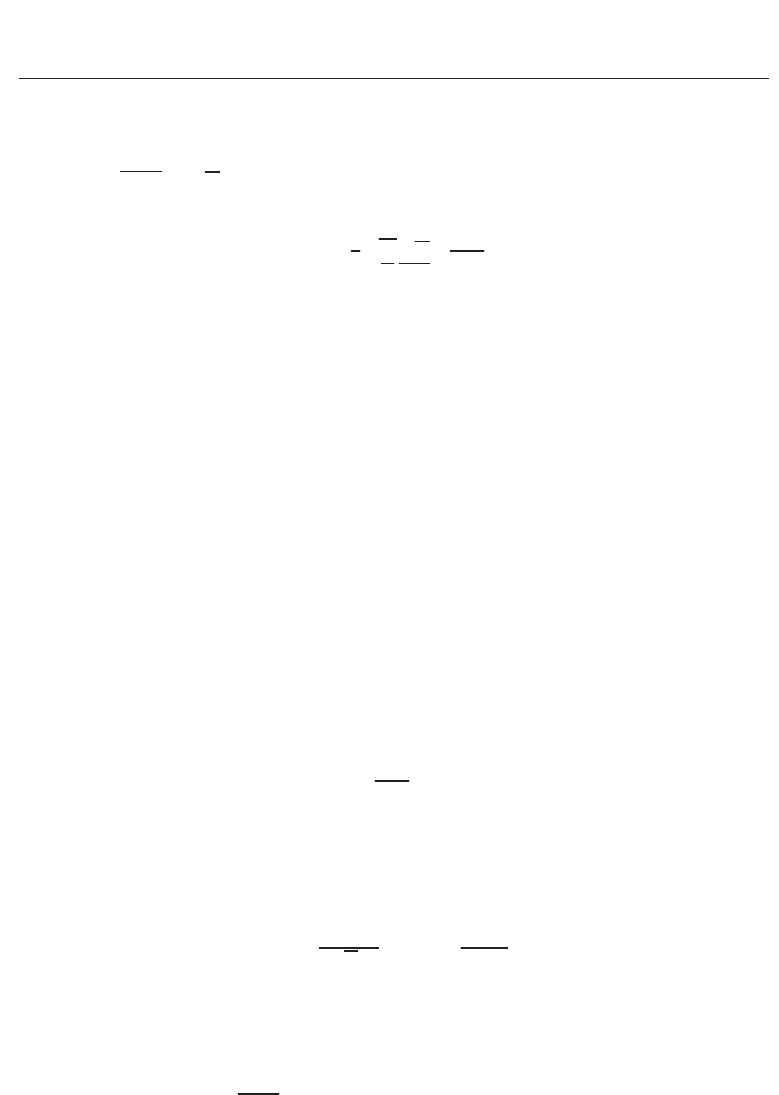
4 Will-be-set-by-IN-TECH
where I is the signal. Both N
shot
and I are expressed in electrons. According to Eq. (7), the
intensity N
shot
of noise is different for each point of the correlogram. For a correlogram with
the form as shown in Fig. 2, the intensity N
shot
of noise in Eq. (7) can be replaced by the
mean value
N
shot
=
√
I
0
. The meaning of the offset I
0
isshowninFig. 2. Themeasurement
uncertainty caused by the shot noise is then given by
δz
=
√
2
4
2
π
√
I
0
I
A
Δzl
c
.(8)
The intensities I
0
and I
A
in Eq. (8) are again expressed in electrons.
Until now, the influence of both effects (rough surface and shot noise) have been studied
separately. The goal of this work is to find the measurement uncertainty of white-light
interferometry influenced by both effects. Similar to (Pavlíˇcek & Hýbl, 2008), the calculations
are performed numerically.
2. Assumptions
We understand the measurement uncertainty as the standard deviation of the distribution
of the measurement error (the difference between the estimate and the true value). For the
calculation of the error caused by surface roughness and shot noise, we take into consideration
following assumptions:
1. The surface is macroscopically planar and microscopically rough. The height h
j
of the j-th
scattering center is a normally distributed random variable with zero mean. The standard
deviation of the height distribution is equal to the rms roughness σ
h
. The number of
scattering centers inside of the resolution cell of the imaging system is n.
2. Because of the different reflectivity of the scattering centers, the amplitude a
j
of the light
reflected from j-th scattering center is a random variable obeying uniform distribution
from 0 to A
M
. The resultant amplitude of the light reflected from the measured surface is
given by (Goodman, 1984)
ˆ
A
=
n
∑
j=1
a
j
n
1/2
exp(i2kh
j
).(9)
We assume that the amplitudes a
j
and heights h
j
are independent of each other and the
amplitudes a
j
do not depend on wave number k.
3. The spectral density of the broadband light has Gaussian form
S
(k)=
1
2
√
πΔk
exp
−
k
−k
0
2Δk
2
, (10)
where k
0
= 2π/λ
0
is the central wave number and Δk = 1/(2l
c
) is the effective band
width in wave number units (Born & Wolf, 2003). The effective bandwidth Δk can be
calculated from the spectral width Δλ by means of Eq. (4).
4. The noise is a signal-independent normally distributed random variable with zero mean
and standard deviation
N
shot
.
494
Numerical Simulations of Physical and Engineering Processes
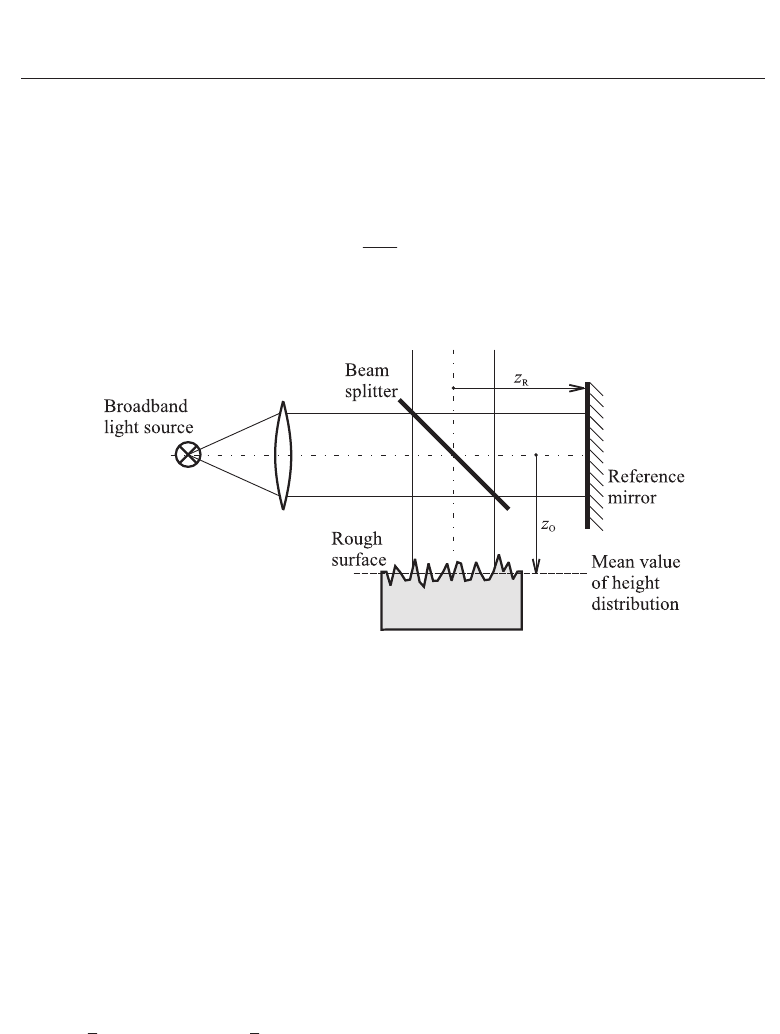
Measurement Uncertainty of White-light Interferometry on Optically Rough Surfaces 5
3. Simulation
3.1 Generation of the correlogram
The phasor amplitude of light having passed through the object arm with the rough surface
is, according to Eq. (9), given by
ˆ
A
(k, z
O
)=
n
∑
j=1
a
j
n
1/2
exp[i2k(z
O
+ h
j
)]. (11)
The position z
O
of the rough surface is given by the position of the mean value of height
distribution as shown in Fig. 4.
Fig. 4. Object and reference arm of the setup for white-light interferometry.
The phasor amplitude of light having passed the reference arm with the reference mirror is
given by
ˆ
B
(k, z
R
)=B exp(i2kz
R
), (12)
where B is the amplitude of light in the reference arm and z
R
is the position of the reference
mirror. The meaning of both the positions z
O
and z
R
follows from Fig. 4.
The light intensity at the interferometer output is given by
I
k
(k, z
O
−z
R
)=|
ˆ
A(k, z
O
)+
ˆ
B
(k, z
R
)|
2
. (13)
The subscript k means that I
k
is the intensity calculated for the wave number k. To obtain
the total intensity at the output of the interferometer, I
k
must be integrated over all wave
numbers. Because the light components with various wave numbers are not uniformly
distributed in the spectrum, I
k
must be multiplied by spectral density S(k). Theoretically, the
integration should be performed over the whole interval
(−∞, ∞). However, the integration
is calculated numerically and therefore we restrict the calculation on a finite interval which
corresponds to three standard deviations on each side from the central wave number: k
min
=
k
0
−3
√
2Δk, k
max
= k
0
+ 3
√
2Δk
I
(z
O
−z
R
)=
k
max
k
min
S(k)I
k
(k, z
O
−z
R
)dk. (14)
495
Measurement Uncertainty of White-Light Interferometry on Optically Rough Surfaces
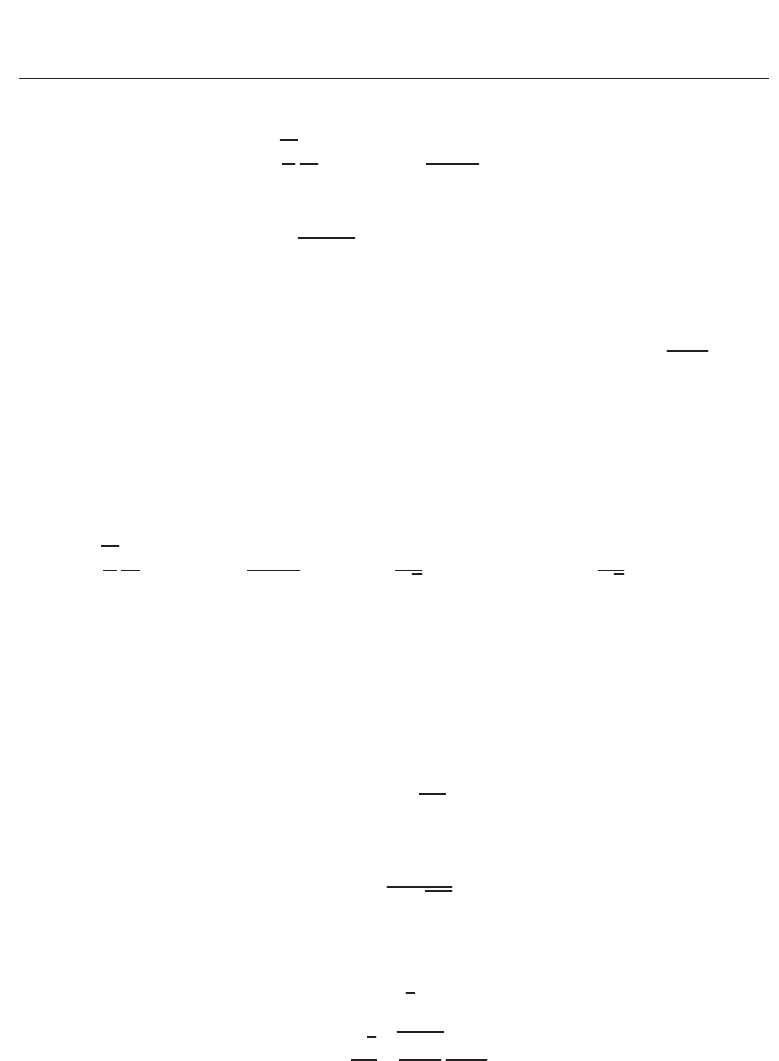
6 Will-be-set-by-IN-TECH
The integration in Eq. (14) is transformed to a sum
I
(z
O
−z
R
)=
2
π
3
n
k
n
k
∑
l=1
exp
−
k
l
−k
0
2Δk
2
I
k
(k
l
, z
O
−z
R
) (15)
with
k
l
=
l −1/2
n
k
(k
max
−k
min
)+k
min
. (16)
In Eqs. (15) and (16), n
k
is the number of used wave numbers.
Equation (15) for the intensity I expressed as a function of the coordinate z
O
, while the
coordinate z
R
is constant, describes the correlogram. The correlogram is calculated for n
c
points (values of the coordinate z
O
). The calculated correlogram is superposed by the noise
with normal distribution and a constant (signal independent) standard deviation
N
shot
.
I
n
(z
m
)=I(z
m
)+N
m
(17)
with z
m
= mΔz for m = 1, ..., n
c
.
The local intensity I
obj
of the speckle pattern that appears in Eqs. (1), (2), and (5) can be
calculated from Eq. (15) for B
= 0 (the reference arm is shut) and an arbitrary value of
z
O
. Because the expression for I
obj
contains no interference term, it does not depend on the
coordinate z
O
. For simplicity we choose z
O
= z
R
I
obj
=
2
π
3
n
k
n
k
∑
l=1
exp
−
k
l
−k
0
2Δk
2
⎡
⎢
⎣
⎛
⎝
n
∑
j=1
a
j
√
n
cos
(2k
l
h
j
)
⎞
⎠
2
+
⎛
⎝
n
∑
j=1
a
j
√
n
sin
(2k
l
h
j
)
⎞
⎠
2
⎤
⎥
⎦
.
(18)
The mean intensity of the speckle pattern is given by
I
obj
= a
2
j
. (19)
According to Eq. (12), the intensity of the reference beam is
I
ref
= B
2
. (20)
Thus the amplitude of the modulation is given by
I
A
= 2B
I
obj
(21)
and the noise-to-signal ratio is equal to
NSR
=
N
shot
2B
I
obj
. (22)
If the amplitudes
{a
j
} obey uniform distribution from 0 to A
M
as postulated in assumption 2
in Sec. 2
I
obj
=
1
3
A
2
M
(23)
and
NSR
=
√
3
2
I
obj
I
obj
N
shot
A
M
B
. (24)
The heights
{h
j
}, amplitudes {a
j
} and noise values {N
m
} used for the simulation are random
numbers. The random numbers have been generated by quantum random number generator
developed in the Joint Laboratory of Optics (Soubusta et al., 2003).
496
Numerical Simulations of Physical and Engineering Processes

Measurement Uncertainty of White-light Interferometry on Optically Rough Surfaces 7
3.2 Evaluation of the correlogram
The obtained noised correlogram is evaluated to find the "measured" value z
M
of the surface.
The value z
M
is determined from the maximum of the envelope of the correlogram. The
meaning of z
M
isshowninFig.2.
The envelope of the correlogram is calculated using a discrete Hilbert transform. The
calculation of the envelope can be described in five steps (Onodera et al., 2005). In the
first step, the mean intensity I
0
is subtracted from the correlogram. In this way, the zero
mean correlogram is obtained. In the second step, the zero mean correlogram is Fourier
transformed. In the third step, the Fourier transform is multiplied by the imaginary unit (i)
for positive frequencies and by the negative of the imaginary unit (-i) for negative frequencies.
In the fourth step, the result is inversely Fourier transformed. Thus the Hilbert transform of
the zero mean correlogram is obtained. The Hilbert transform of the correlogram alters its
phase by π/2. Finally, in the fifth step, the Hilbert transform of the zero mean correlogram is
squared and added to the square of the zero mean correlogram itself for each value of z
O
.The
square root of this sum is the value of the envelope of the correlogram for the given value of
z
O
.
The position z
M
of the maximum of the envelope is estimated by use of the least-squares
method (Press et al., 1992). The sought measurement error is the difference between the
estimate and the true value. Without the influence of surface roughness and shot noise, the
maximum of the envelope would be located at z
M
= z
R
. Therefore, the measurement error is
mathematically expressed by
Δ
= z
M
−z
R
. (25)
4. Results of the simulation
Here the results of the simulation are presented. The quantities are calculated numerically for
n
s
speckles, each of them calculated using a set of values {h
j
}, {a
j
},and{N
m
}; j = 1, 2, ..., n,
m
= 1, 2, ..., n
c
.Thesets{h
j
} have a normal distribution with the standard deviation σ
h
.
The sets
{a
j
} have a uniform distribution from 0 to A
M
and the sets {N
m
} have a normal
distribution with the standard deviation
N
shot
.
4.1 Distribution of the intensity
First, the attention is given to the intensity distribution in the object arm. Intensity I
obj
is
calculated from Eqs. (15), (13), and (11) with B
= 0andz
O
= z
R
. The parameters of the
simulation are n
s
= 20 000, n = 200, n
k
= 200, A
M
= 1.
Figure 5 displays the results of the calculated intensity distribution for λ
0
= 820nm, σ
h
=
1.2μm, and three values of spectral width Δλ = 10, 38, and 80nm.
The numerically calculated results are compared with the solutions obtained from Eq. (2).
The gamma distribution described by Eq. (2) is plotted in Fig. 5 with a dashed curve. The
numerically obtained results are in good agreement with the analytical solutions as follows
from Fig. 5. The variance of the intensity distribution described by Eq. (2) is equal to
var
{I
obj
} =
I
obj
2
M
. (26)
The contrast of the speckle pattern is given by (Parry, 1984)
C
=
var{I
obj
}
I
obj
(27)
497
Measurement Uncertainty of White-Light Interferometry on Optically Rough Surfaces
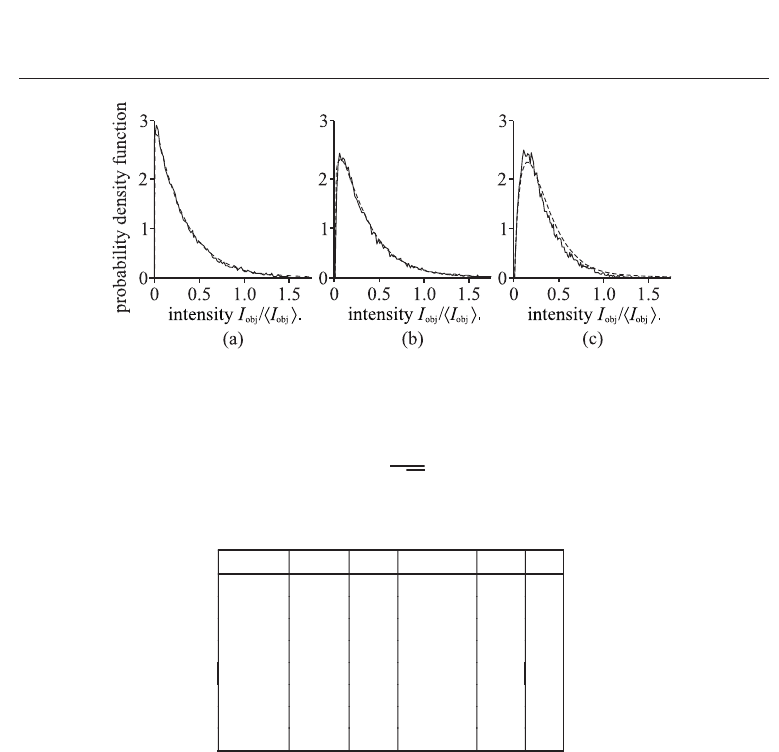
8 Will-be-set-by-IN-TECH
Fig. 5. Intensity distribution for λ
0
= 820nm, σ
h
= 1.2μm.(a)Δλ = 10nm.(b)Δλ = 38nm.(c)
Δλ
= 80nm.
and from Eq. (26), it follows
C
=
1
√
M
. (28)
In Table 1, the values of contrast C
num
calculated numerically from Eq. (27) are compared with
the values of contrast C obtained by means of Eqs. (3) and (28). Because A
M
= 1, the mean
Δλ(nm) l
c
(μm) I
obj
var{I
obj
} C
num
C
10 17.8 0.335 0.110 0.99 0.99
20 8.9 0.333 0.106 0.98 0.97
30 5.9 0.333 0.097 0.94 0.93
40 4.5 0.333 0.089 0.90 0.89
50 3.6 0.335 0.081 0.85 0.85
60 3.0 0.334 0.074 0.81 0.81
70 2.5 0.335 0.066 0.77 0.77
80 2.2 0.336 0.062 0.74 0.74
Table 1. Numerically calculated speckle contrast for various spectral widths of the light
source (λ
0
= 820nm, σ
h
= 1.2μm)
intensity
I
obj
of the speckle pattern is equal approximately to 1/3 according to Eq. (23).
The dependence of the contrast C
num
on the spectral width Δλ is plotted in Fig. 6(a). This
dependence is an analogy to the dependence of the contrast on the illumination aperture
as described in (Häusler, 2005). For comparison, the dependence of the contrast on the
illumination aperture is illustrated in Fig. 6(b).
4.2 Distribution of the measurement error
The distribution of the measurement error caused by surface roughness and shot noise is
calculated numerically using Eq. (25). The parameters of the simulation are n
s
= 20 000,
n
c
= 1024, n = 200, n
k
= 200, A
M
= 1, B = 1. As an example, the distribution of the
measurement error is calculated for λ
0
= 820nm, Δλ = 35nm, σ
h
= 0.4μm, I
obj
= I
obj
,
Δz
= λ
0
/10, and N
shot
= 0.0577. The relation I
obj
= I
obj
means that only those cases are
entered into the statistics when the intensity I
obj
falls into a certain neighborhood of the mean
intensity
I
obj
. The noise-to-signal ratio is equal to NSR = 0.05 according to Eq. (24). The
results of the calculation are presented in Fig. 7.
498
Numerical Simulations of Physical and Engineering Processes
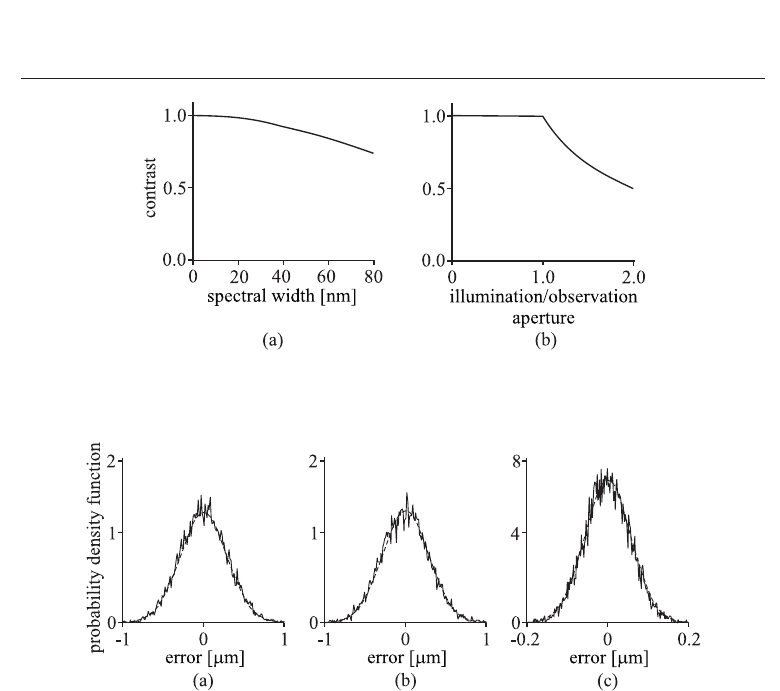
Measurement Uncertainty of White-light Interferometry on Optically Rough Surfaces 9
Fig. 6. (a) Speckle contrast as a function of spectral width (numerically calculated data) for
λ
0
= 820nm, σ
h
= 1.2μm. (b) Speckle contrast as a function of illumination aperture
according to Häusler.
Fig. 7. Distribution of the measurement error for λ
0
= 820nm, Δλ = 35nm, σ
h
= 0.4μm,
I
obj
= I
obj
,andNSR= 0.05. (a) Error caused by surface roughness and shot noise. (b) Error
caused by surface roughness only. (c) Error caused by shot noise only.
The distribution of the measurement error for the noised correlogram on rough surface is
shown in Fig. 7(a). Figure 7(b) shows the distribution of the measurement error for the
correlogram without noise. Finally, the distribution of the measurement error for the noised
correlogram on smooth surface is illustrated in Fig. 7(c). It shows up that the distribution of
the measurement error tends in all three cases to a normal distribution centered at zero. For
comparing, the shape of the normal distribution is plotted by dashed line in Fig. 7. The zero
mean of the calculated distribution means that the expected value of the measured coordinate
is the mean value of height distribution within the resolution cell. The standard deviation of
the calculated distribution is the sought measurement uncertainty. In the given example, the
numerically calculated measurement uncertainties are δz
= 0.293μm, δz
rough
= 0.288μm,and
δz
noise
= 0.055μm for the cases shown in Figs. 7(a), 7(b), and 7(c), respectively.
It is apparent that it holds
(δz)
2
=(δz
rough
)
2
+(δz
noise
)
2
. (29)
This result is to be expected, because the influences of the noise and of the rough surface
are independent. A sum of two independent random variables with normal distribution and
499
Measurement Uncertainty of White-Light Interferometry on Optically Rough Surfaces
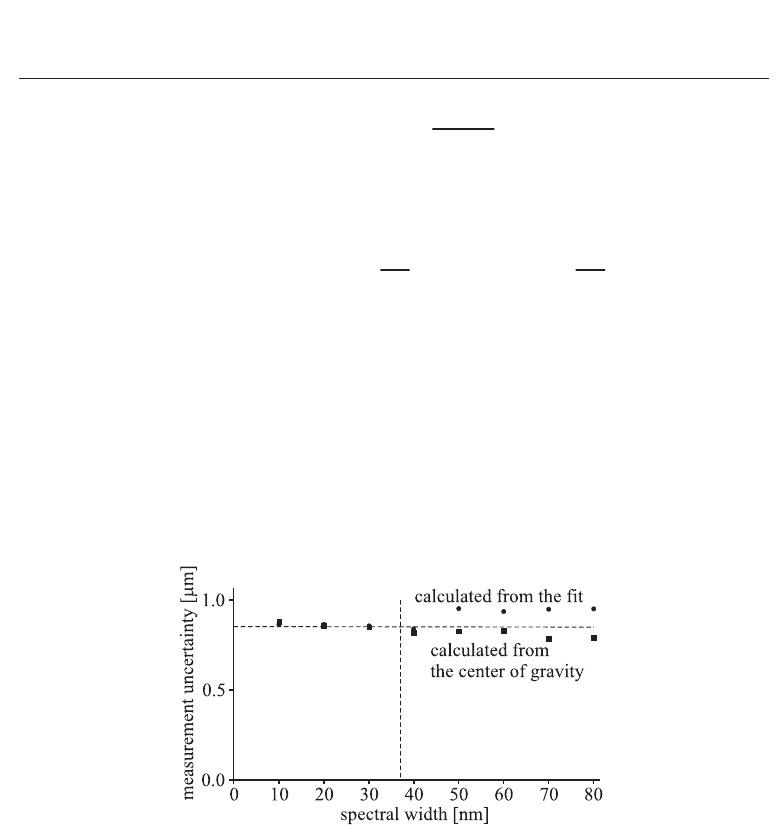
10 Will-be-set-by-IN-TECH
the standard deviations equal to σ
A
and σ
B
, respectively, is a random variable with normal
distribution and standard deviation equal to σ
=
σ
2
A
+ σ
2
B
.
The numerically calculated measurement uncertainties are compared with the theoretical
values calculated from Eqs. (1) and (6). For the abovementioned example, the theoretical
results are δz
= 0.286μm, δz
rough
= 0.283μm,andδz
noise
= 0.041μm which is in a good
agreement with the numerical calculations. The numerically calculated value of δz
noise
is
higher than the theoretical prediction. The reason is that the fit is performed on a limited
interval of the longitudinal coordinate (
−
√
3/2l
c
< z
O
− z
M
<
√
3/2l
c
). The numerical
calculations for other values of λ
0
, Δλ, σ
h
, I
obj
, Δz,andN
shot
confirm the validity of Eq. (29).
By comparing the values δz
rough
and δz
noise
, it is apparent that the influence of rough surface
is significantly higher for "usual" values of spectral width, sampling step and noise-to-signal
ratio. However, when white-light interferometry is operated with a narrow-band light source
or with an extremely long sampling step, the influence of noise will increase. Equations (1)
and (6) enable to compare the influences of both effects.
4.3 Measurement uncertainty
The measurement uncertainty caused by surface roughness and shot noise is calculated as
function of the spectral widht Δλ. The parameters of the simulation are n
s
= 10 000, n
c
=
1024, n = 200, n
k
= 200, A
M
= 1, B = 1. Figure 8 shows the result for λ
0
= 820nm,
σ
h
= 1.2μm, I
obj
= I
obj
,andNSR= 0.05 as an example.
Fig. 8. Numerically calculated measurement uncertainty δz as a function of spectral width
Δλ for λ
0
= 820nm, σ
h
= 1.2μm, I
obj
= I
obj
,andNSR= 0.05.
The circles indicate the values calculated from the fit using the least-squares method. The
squares correspond to the values calculated from the center of gravity of the correlogram
envelope (Pavlíˇcek & Hýbl, 2008). For small values of the spectral width, both methods
yield approximately same results. The numerically calculated measurement uncertainty
corresponds to the value calculated using Eqs. (29), (1), and (6). This value is indicated by
the horizontal dashed line for the respective values of σ
h
, I
obj
, and NSR. In fact, the line
is slightly inclined because the measurement uncertainty caused by shot noise depends on
spectral width of the used light according to Eq. (6).
After the spectral width exceeds the spectral width corresponding to the limit coherence
length given by Eq. (5), the values calculated from the fit begin to differ from those calculated
from the center of gravity. The limit spectral width for the respective values of σ
h
and I
obj
is indicated by the vertical dashed line in Fig. 8. The measurement uncertainty calculated
500
Numerical Simulations of Physical and Engineering Processes

Measurement Uncertainty of White-light Interferometry on Optically Rough Surfaces 11
from the fit begins to increase. The reason is the distortion of the correlogram as shown in
Fig. 3. The fitting of the envelope and its evaluation by means of least-squares method is
no more as accurate as for an undistorted correlogram. On the other hand, the evaluation
of a distorted correlogram by means of the center of gravity is more accurate than that of
an undistorted correlogram (Pavlíˇcek & Hýbl, 2008). For a light source with an extremely
large spectral width Δλ
= 120nm (other conditions are the same as above), the measurement
uncertainty calculated from the center of gravity sinks to 0.770μm.
5. Conclusion
The influence of rough surface and shot noise on measurement uncertainty of white-light
interferometry on rough surface has been investigated. It has shown that both components of
measurement uncertainty add geometrically. The numerical simulations have shown that the
influence of the rough surface on the measurement uncertainty is for usual values of spectral
width, sampling step and noise-to-signal ratio significantly higher than that of shot noise.
The influence of rough surface prevails over the influence of shot noise. The obtained results
determine limits under which the conditions for white-light interferometry can be regarded as
usual. For low values of spectral width and high values of sampling step and noise-to-signal
ratio, the influence of the noise must be taken into account.
6. Acknowledgement
This research was supported financially by Operational Program Research and Development
for Innovations - European Social Fund (project CZ.1.05/2.1.00/03.0058 of the Ministry of
Education, Youth and Sports of the Czech Republic).
7. References
Born, M. & Wolf, E. (2003). Principles of Optics, Cambridge University Press, Cambridge.
Dresel, T. (1991). Grundlagen und Grenzen der 3D-Datengewinnung, Master’s thesis, University
Erlangen-Nuremberg, Erlangen.
Dresel, T., Häusler, G. & Venzke, H. (1992). Three-dimensional sensing of rough surfaces by
coherence radar, Applied Optics Vol. 31 (No. 7): 919–925.
George, N. & Jain, A. (1973). Speckle reduction using multiple tones of illumination, Applied
Optics Vol. 12 (No. 6): 1202–1212.
Goodman, J. W. (1984). Statistical properties of laser speckle patterns, in Dainty,J.C.(ed.),
Speckle and Related Phenomena, Springer-Verlag, pp. 9–75.
Häusler, G., Ettl, P., Schenk, M., Bohn, G. & László, I. (1999). Limits of optical range sensors
and how to exploit them, in International Trends in Optics and Photonics ICO IV,Vol.74
Springer Series in Optical Sciences, Springer-Verlag, Berlin, pp. 328–342.
Häusler, G. (2005 ). Speckle and coherence, in Guenther, B. D. (ed.), Encyclopedia of Modern
Optics, Elsevier, Academic Press, Amsterdam, pp. 114–123.
Horváth, P., Hrabovský, M. & Baˇca, Z. (2002). Statistical properties of a speckle pattern, in
Proc. SPIE, Vol. 4888, pp. 99–108.
Kino, G. S. & Chim, S. S. C. (1990). Mirau correlation microscope, Applied Optics Vol . 2 9 ( No.
26): 3775–3783.
Lee, B. S. & Strand, T. C. (1990). Profilometry with a coherence scanning microscope, Applied
Optics Vol. 29 (No. 26): 3784–3788.
501
Measurement Uncertainty of White-Light Interferometry on Optically Rough Surfaces

12 Will-be-set-by-IN-TECH
Onodera, R., Watanebe, H. & Ishii, Y. (2005). Interferometric phase-measurement using a
one-dimensional discrete Hilbert transform, Optical Rewiev Vol. 12 (No. 1): 29–36.
Parry, G. (1984). Speckle patterns in partially coherent light, in Dainty,J.C.(ed.),Speckle and
Related P henomena, Springer-Verlag, pp. 77–121.
Pavlíˇcek, P. & Hýbl, O. (2008). White-light interferometry on rough surfaces – measurement
uncertainty caused by surface roughness, Applied Optics Vol. 47 (No. 16): 2941–2949.
Pavlíˇcek, P. & Hýbl, O. (2011). Pavlíˇcek, P. Palacky University, Faculty of Science, Regional
Centre of Advanced Technologies and Materials, Joint Laboratory of Optics of
Palacky University and Institute of Physics of Academy of Science of the Czech
Republic, & Hýbl, O. are preparing a manuscript to be called: Theoretical limits of
the measurement uncertainty of white-light interferometry.
Peˇrina, J. (1991). Quantum statistics of linear and nonlinear optical phenomena,KluwerAcademic
Publishers, Dordrecht.
Press, W. H., Teukolsky, S. A., Vettering W. T. & Flannery B. P. (1992). Numerical Recipes in C:
The Art of Scientific Computing, Cambridge University Press, Cambridge.
Soubusta,J.,Haderka,O.,Hendrych,M.&Pavlíˇcek, P. (2003). Experimental realization of
quantum random generator, in Proc. SPIE, Vol. 5259, pp. 7–13.
502
Numerical Simulations of Physical and Engineering Processes
